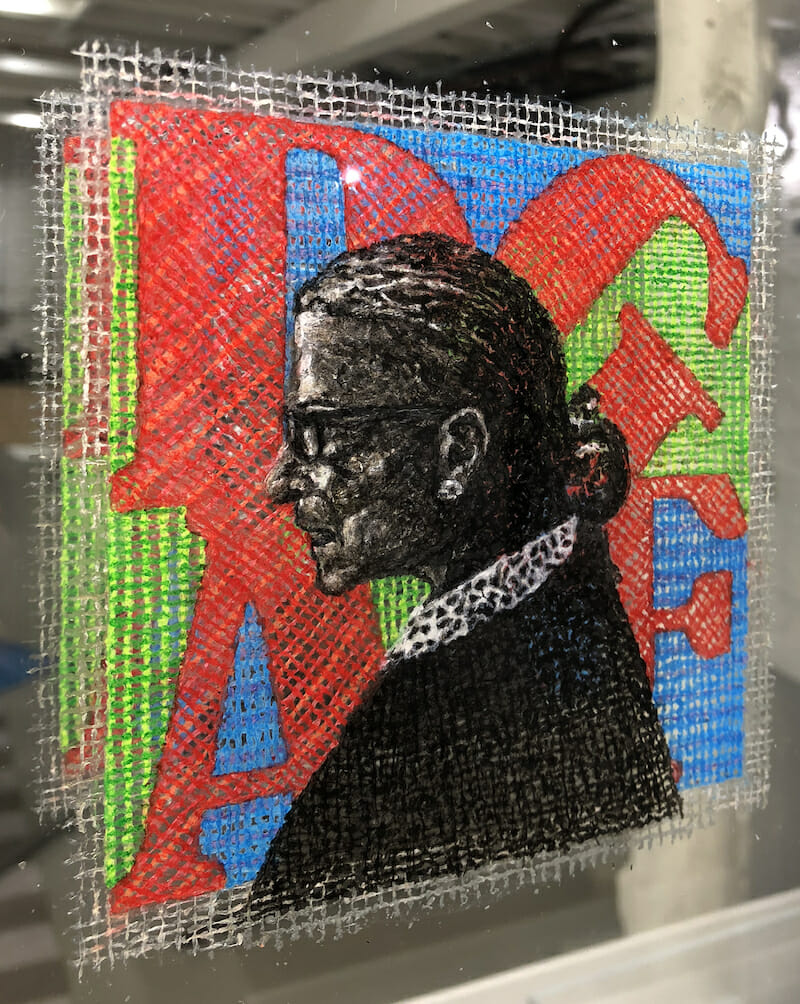Ruth Bader Ginsburg’s Fandom Grows With ‘Notorious RBG’ Show
If the book, documentary or T-shirt isn’t enough, a new exhibit dedicated to the ever-popular Supreme Court justice gives admirers another outlet to express their enthusiasm. This image used as a tattoo of Ruth Bader Ginsburg is included in the traveling exhibit, "The Notorious RBG," dedicated to the long-serving Supreme Court justice. (Ari Richter)
This image used as a tattoo of Ruth Bader Ginsburg is included in the traveling exhibit, "The Notorious RBG," dedicated to the long-serving Supreme Court justice. (Ari Richter)
Five years ago, Supreme Court Justice Ruth Bader Ginsburg rose to internet fame as the Notorious RBG—a nod to the late rapper Notorious B.I.G.—when law student Shana Knizhnik created a Tumblr account dedicated to her favorite jurist.
“It was the same day a narrow majority of Supreme Court justices gutted the Voting Rights Act,” Knizhnik told Truthdig about her reasons for starting the Tumblr site. “They did so under a theory that racism was over.” Ginsburg dissented in the case. “In doing so she sent a message to her fellow colleagues but also to me about what was happening,” Knizhnik said. “I heard it loud and clear.
Knizhnik clung to Ginsburg’s hope for a better day. “That’s what I wanted to achieve with the Notorious RBG Tumblr. Two words, ‘I Dissent,’ started the phenomenon,” she said. “What better way … than to compare her to the late great rapper Biggie Smalls,” Knizhnik added, noting that both figures hailed from Brooklyn. Soon, the Notorious RBG idea launched a cottage industry, carving out a space in popular culture to celebrate the feminist justice who is small in stature and fierce in nature. Merchandising opportunities included coffee mugs, action figures, bobbleheads in black robes, even tattoos of her face (which baffled Ginsburg) and T-shirts emblazoned with the saying, “You can’t spell truth without Ruth.”
Now an exhibition in Los Angeles is taking the concept one step further. Through March 10, 2019, the Skirball Cultural Center is featuring “Notorious RBG: The Life and Times of Ruth Bader Ginsburg.” Based on the 2015 book by the same name, the show was created in partnership with its authors, Knizhnik and journalist Irin Carmon.
At 85 years old, Ginsburg, a two-time cancer survivor, has achieved her own version of the EGOT (Emmy, Grammy, Oscar and Tony awards) with a documentary, best-selling book, the show at the Skirball and an upcoming feature film, “On the Basis of Sex,” starring British actress Felicity Jones.
Planned two years ago, the Skirball exhibit couldn’t have opened at a more apropos time in history, given the recent developments in women’s rights, from the Women’s March protests that launched in 2017 to the ongoing MeToo movement and, more specific to the Supreme Court context, the recent and controversial appointment of Brett Kavanaugh to the court.
Marking the 25th anniversary of the 1993 appointment of Ginsburg, the second female to serve on the high court (the first was Sandra Day O’Connor), the exhibition explores the life and work of the trailblazing associate justice, starting with her early roles as a student, wife, mother, lawyer and civil rights pioneer. “Visitors are greeted by her beautiful black robe, on loan from the justice, her bow, trademark dissenting jabots (collars), which hold specific meanings, and official portrait by Everett Raymond Kinstler,” curator Kate Thuston said.
Also on display are photographs, documents, artifacts, art and interactive media stations. Visitors can look inside a recreation of Ginsburg’s childhood living room in Brooklyn while listening to opera music playing on an antique radio (her favorite opera is “The Marriage of Figaro”) or try on a judge’s robe while sitting on a re-created version of her Supreme Court bench. They can also watch home movies of Ginsburg and her husband, Martin Ginsburg, who did his share of household chores while his wife worked late, or check out his recipes (he served as the amateur chef of the household). There’s even a letter from Ginsburg’s late husband on display that can move readers to tears.
Also of interest is information on how Ginsburg was not President Bill Clinton’s first choice for the Supreme Court position, and how watching McCarthyism affect members of her community influenced her decision to become a lawyer. As a new mom, Ginsburg was one of eight women at Harvard University, where female-only bathrooms were unavailable at the time. She went on to graduate first in her class from Columbia Law School in 1959.
Taught to be ladylike, Ginsburg was docile and impassive early in her career, but her struggles for female equality turned the native New Yorker into the firebrand she is today. That spirit is evident in famous cases, included in the Skirball show, from her America Civil Liberties Union Women’s Rights Project. In Weinberger v. Wiesenfeld from 1975, for example, Ginsburg effectively argued before the Supreme Court on behalf of a male widower who was denied Social Security survivor benefits typically given to widows, reasoning that gender-based distinctions violated the right to equal protection.
After its stint at the Skirball, “Notorious RBG: The Life and Times of Ruth Bader Ginsburg” will be featured at the National Museum of American Jewish History in Philadelphia; the Illinois Holocaust Museum in Skokie, Ill.; and the Contemporary Jewish Museum in San Francisco.
Meanwhile, the woman who inspired the show continues to rule from her spot on the bench in Washington, D.C.
Your support matters…Independent journalism is under threat and overshadowed by heavily funded mainstream media.
You can help level the playing field. Become a member.
Your tax-deductible contribution keeps us digging beneath the headlines to give you thought-provoking, investigative reporting and analysis that unearths what's really happening- without compromise.
Give today to support our courageous, independent journalists.








You need to be a supporter to comment.
There are currently no responses to this article.
Be the first to respond.